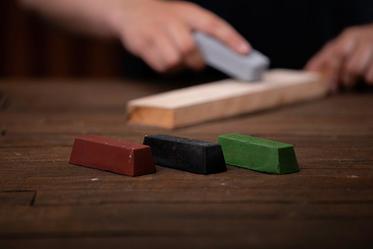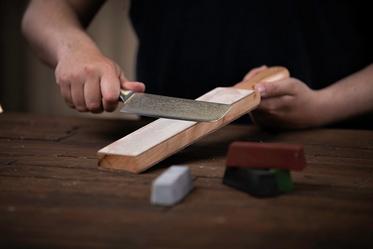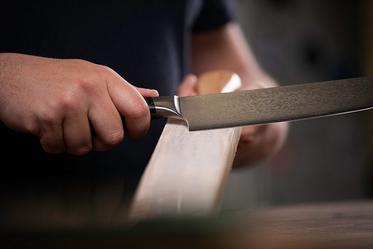Stropping a knife
Polishing the edge of your knife is called stropping. It is the final step in the sharpening process. You can only use a strop after you're done sharpening your knife with a very fine sharpening stone. Stropping removes the tiny imperfections on the edge of your knife, so the knife will be perfectly sharpened and the edge can shine like a mirror. Stropping is also the perfect way to keep your knife razor-sharp. We will explain how it works.
Let's start by determining whether your knife can be stropped at all. Is your knife serrated? Then it cannot be stropped. Stropping a serrated edge would damage the strop, and it wouldn't even sharpen the serrated knife. Knives with a recurve (a curved blade, like a turning knife) are very difficult to strop. You could pull it off with a strop after some practice, but don't even try it with a stropping paddle. Lastly, it is important to make sure that your knife has been properly sharpened before you begin stropping. If this is not the case, then stropping is a wasted effort. So be sure that the knife is really razor-sharp. Only then can you start stropping!
After what grit size can I begin stropping?
It depends on the knife, the strop and the stropping compound you're using. As a general guideline, we assume the following: a knife is ready for stropping after it's been sharpened with a sharpening stone of 5000 grit (JIS).
Should I be using stropping compounds?
You don't have to, since leather has a natural stropping effect. However, are you going for a more effective strop, or do you want to use a certain micron? Then yes, you can choose to use a stropping compound, paste or spray. These are abrasives that enhance the polishing effect of your strop. Do you want the absolute best result? Start with a coarse stropping compound and work your way up to the smallest microns. It's the same concept as sharpening with sharpening stones. It's also fine to just use one strop with one stropping compound! In this case, choose as medium stropping compound, between 5 and 2 micron.
How often should I apply the stropping compound?
Once you apply the stropping compound to the strop, it won't come off easily. If you use the strop on a weekly basis, the applied compound will be effective for at least a month. However, to increase the effectiveness of the stropping compound, it can't hurt to add a little compound now and then.
Placing the knife on the strop
You can start by placing the tip of the blade on the strop. Make sure that the back of the blade is facing you. When it comes to stropping, you don't have to be very precise with the sharpening angle. The leather will lightly bend to fit the edge. You'll notice soon enough if you're doing it right: if the side of the blade starts to shine instead of the edge of the blade, you'll know to increase the angle. Do you hear a scraping noise? Then use a slightly smaller angle.
Movement
Placing the tip of your blade on the strop is your first step. Pull the knife over the strop towards you, until the heel of the knife has reached the top of the strop. Repeat this several times, and then strop the other side of the edge. As you can see, we're not cutting into the strop, as that would significantly damage the leather.
You barely need to apply any pressure during stropping. The weight of your hand and the knife is usually enough. Let the strop and the stropping compound do their job. How many times should you be pulling the knife over the strop? This depends on the knife, the strop and the compound you're using. Repeat the movement as often as necessary until you're satisfied with the shine of your knife.
Mind the belly!
Be careful to follow the profile of the blade during stropping. Does the knife have a bit of a belly like this one? Then you should follow the cut of the blade by moving your wrist, not your entire arm. By only moving your wrist, the stropping will be more accurate and in the end, faster.
Roughening up your strop
You will notice that after a lot of use, the strop might turn black. Don't worry! This simply means that the strop is doing its job. The black colour comes from the metal that you have polished off the edge of your knife. If your strop is black, and starts gleaming, then it's time to roughen it up. This makes the strop more effective.
The goal is to create shallow little cuts in the leather. Fortunately, there are many ways to roughen up a strop. You could, for example, use a steel wire brush! Try not to start out too roughly, instead gently start increasing the pressure to roughen up the leather.
A saw could work too! You can roughen up the surface by moving the saw over the strop sideways. Make sure to be extra careful! A saw can damage the strop, or yourself!




?%24center=center&%24poi=poi&%24product-image%24=&fmt=auto&poi=%7B%24this.metadata.pointOfInterest.x%7D%2C%7B%24this.metadata.pointOfInterest.y%7D%2C%7B%24this.metadata.pointOfInterest.w%7D%2C%7B%24this.metadata.pointOfInterest.h%7D&scaleFit=%7B%28%24this.metadata.pointOfInterest%29%3F%24poi%3A%24center%7D&sm=c&w=373)


?%24center=center&%24poi=poi&%24product-image%24=&fmt=auto&poi=%7B%24this.metadata.pointOfInterest.x%7D%2C%7B%24this.metadata.pointOfInterest.y%7D%2C%7B%24this.metadata.pointOfInterest.w%7D%2C%7B%24this.metadata.pointOfInterest.h%7D&scaleFit=%7B%28%24this.metadata.pointOfInterest%29%3F%24poi%3A%24center%7D&sm=c&w=373)



















